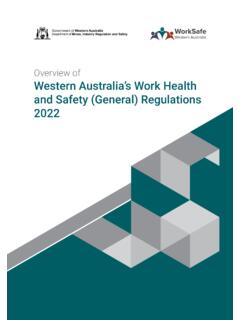Transcription of Section 20 consuitation explained - LBHF
1 Section 20 consultation explained 1 Introduction This booklet give a short summary of the regulations that we, LBHF, must follow when we consult you about work or services which you have to pay. These regulations came into effect in October 2003 as part of the Commonhold and Leasehold Reform Act 2002. This booklet is only a guide. For a fuller explanation of the relevant legislation you may wish to visit the website of the Leasehold Advisory Service ( ) an independent organisation set up by government to provide advice on all leasehold matters. Why must we consult you? Under the terms of your lease, you must pay towards the cost of any services or work to the building your home is in or the estate it is on. You do this by paying a service charge. Under Section 20 of the Landlord and Tenant Act 1985 (amended by Section 151 of the Commonhold and Leasehold Reform Act 2002), we must consult you about some of the work and services that you must pay for.
2 What must we consult you about? On behalf of your landlord (London Borough of Hammersmith & Fulham), we must consult you before we do any of the following. Carry out work which will cost any one leaseholder more than 250. This includes repairs, maintenance and improvements to your building and estate. Enter into a long-term agreement (for more than 12 months) with outside contractors for work, supplies or services which will cost any one leaseholder more than 100 a year. Examples include cleaning, grounds maintenance and surveying. Carry out work under a long-term agreement where the work will cost any one leaseholder more than 250. What is a Section 20 notice? A Section 20 notice (S20) is a notice to tell you that we intend to carry out work or provide a service that leaseholders will have to pay towards. We must serve a S20 on any leaseholder who will be affected by the work or receive the service.
3 We must also send a copy of the S20 notice to any registered tenants association (RTA) that is associated with the building your home is in or the estate it is on. The S20 will include information about what we plan to do and how much it is estimated to cost. It will give you the opportunity to take part in the consultation process and comment on what is being planned. How will we consult you? The Section 20 consultation is only one part of the process that we use to discuss our plans with residents. The S20 process is set out in law and is made up of four schedules, each dealing with a different situation. The schedules are shown below. Section 20 consultation explained 2 Schedule consultation procedure for: Do we need to give a public notice? 1 Long term agreements No 2 Long term agreements Yes 3 Work under a long term agreement No 4 (part 1) Work Yes 4 (part 2) Work No The content of the S20 notice and the procedure we must follow will vary depending on the type of contract and what it is we are planning to do.
4 It also depends on whether we need to give a public notice (See What is a public notice below). Generally, you will get three separate notices under the S20 process, one at each of the following three stages. Pre-tender stage: before we invite contractors to tender for the work (that is, to give an estimated cost). Tender stage: after we have received the tenders (estimates). Award of contract stage: when we award the contract to the successful tender. There are separate sections in this booklet that explain the different schedules. How can you take part in the consultation ? You have the right to give us your views and comments on the plans during the consultation period. Each stage lasts for 30 days. The council must take note of any comments it receives and carefully consider the comments and suggestions about the work or the long-term agreement. Where we are planning to do major work, we will hold a meeting for residents before you receive the S20 notice.
5 This will give you an opportunity to hear about the work we are planning and for you to comment on that work. In some circumstances, you will have the right to suggest a person, firm or contractor who you would like to tender for the work or long-term agreement. This does not apply in those schedules where we have to give a public notice. What is a public notice? A public notice allows firms and contractors from other EU (European Union) countries to tender for work or long-term agreements. This is set out in the EU procurement rules ( procurement means arranging and paying for work or services). These rules cover all large contracts offered by public and government organisations. As a member of the EU, we have to give a public notice for any work that is worth over 4,322,012 ( 5,186,012), Supplies 172,514 ( 207,000) and Services 172,514 ( 207,000). These thresholds are effective from 1 January 2014 and apply to the total contract value (net of VAT) and not the annual amounts.
6 These values vary depending on the value of the pound Sterling ( ) against the euro ( ). We must publish the public notice in the Official Journal of the European Union (OJEU). Section 20 consultation explained 3 Where we do not have to give a public notice, you do not have the right to suggest a contractor to tender for the work or long-term agreement. We must however still carefully consider any comment you make about the work or services we are planning. What happens if we don t consult you? If we do not follow the regulations, we are limited to how much we can charge you for the work or service. Currently, the limits are 250 per item of repair work and 100 for services that we provide under a long-term agreement. In certain circumstances, we can apply to the first tier tribunal (FTT) for dispensation . If the FTT gave us dispensation, we would not have to follow the rules fully.
7 However, we would have to satisfy the FTT that we had taken all reasonable steps to make leaseholders aware of our plans or that the situation was an emergency. An example of an emergency might be repairing a lift in a tower block. Explaining the schedules Consulting you about long-term agreements Schedules 1 and 2 of the regulations contain the rules under which we must consult you before we enter into any long-term agreements. We must consult you if any work or service that will come out of the long-term agreement will cost you, or any leaseholder, more than the limit set down under the regulation. Currently, the limits are 250 per item of repair work and 100 for services. This notice must go to all leaseholders who will have to pay towards the cost, and any RTA that represents them. The general procedures we must follow 1. Pre-tender stage We must send you a Section 20 notice before we invite contractors to tender.
8 This first notice is known as a notice of intention. This notice must: describe the agreement, or tell you where and when you can see the information and get copies; explain the reasons for entering into the long-term agreement; say why work under the agreement is needed; invite you to make comments on the proposal in writing, and give the address where you should send them; invite you to suggest (nominate) a contractor who we should try and get an estimate from; and give the date on which the consultation period ends and make it clear that we must receive your comments and any nominations before the end of the consultation period. The consultation period will always begin at least 30 days from the date of the notice. We will allow a few extra days between us posting the notice and you receiving it. At this stage, we cannot give you any idea of what you will have to pay towards the work.
9 We can only do this when we get the estimates from the contractors. We must carefully consider any comments and suggestions you make within the consultation period. We will then invite contractors to tender for the work. Section 20 consultation explained 4 2. Tender stage After we have received the tenders, we must prepare two proposals based on the estimates received. One of these must be from a contractor who is not connected with the council. We must also include the tender from any contractor nominated by a leaseholder or the RTA. Each proposal must: describe the work or services that are to be carried out under the agreement; give the name and address of the contractor; explain any connection between the contractor and the council; where possible, give your estimated cost or any other relevant costs; provide details of any arrangements for making changes to the terms of the agreement; say how long the agreement will last; and provide a summary of any comments we received about the first notice (notice of intent) and our response to the comments.
10 We must then send you a second S20 notice. This is known as the notice of proposal. This notice must: include copies of at least two proposals, or say where and when you can see them and get copies; invite you to make comments in writing on the proposals and give you an address to send your comments to; and give the date when the consultation period ends and make it clear that we must receive your comments by the end of the 30-day consultation period. As with the first notice, we must consider any comments you make within the consultation period. 3. Award of contract stage We only need to go through this stage if we awarded the contract to a contractor who did not offer the lowest price or if we did not award the contract to a contractor nominated by a leaseholder or RTA. Generally, we will choose the lowest tender, but if we do not, you will get a third S20 notice, known as an award of contract notice.










